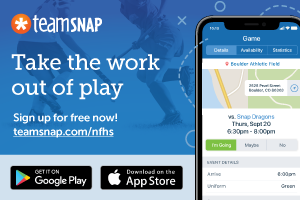3-1-2 ART 2. Sticks shall not be more than 65 inches in length and the blade shall not be more than 12.5 inches in length and no more than 3 inches nor at the tip less than 2 inches high when measured perpendicularly to the normal lie of the stick.
Rationale: Players are taller than ever, as are their sticks and equipment. A change in the maximum length of stick rule follows a similar change to other rules codes. It also would limit the potential waiver requests.
3-1-3 ART 3. The widened portion of the goalkeeper's stick extending up the shaft from the blade shall not extend more than 28 inches from the heel and shall not exceed 3.5 inches in width. The length of the blade shall not exceed 15.5 inches.
Rationale: Players are bigger than ever, as are their sticks and equipment. A change in the maximum length of stick rule follows a similar change to other rules codes. It also would limit the potential waiver requests.
3-4-5 ART 5. All players, including goalkeepers, shall wear helmets and face masks which met HECC/ASTM Standards at the time of manufacture. Helmets and face masks, including ear protectors, shall not be altered from original manufacturer specifications.
NOTE: Compliance with HECC/ASTM Standards requires that helmets and face masks be used no longer than six and a half years after the date of manufacture.
4-7-5 ART 5. Only a player who is ruled a goalkeeper (9-2-1) may defend a penalty shot. The goalkeeper shall remain in the goal crease until the attacking player has touched the puck. The goalkeeper may attempt to stop the puck in any manner except by throwing the stick. If a foul is committed by the goalkeeper during the try and the try is unsuccessful, another penalty shot shall be awarded.
Rationale: This change clarifies that only goalkeepers are able to defend a penalty shot, and also establishes that only players in goalkeeper equipment are given goalkeeper privileges, regardless of when they are substituted.
5-3i The duties of the referees are as follows:
i. Suspend the game if playing conditions become unsatisfactory.
Rationale: Terminate, by definition means to end. Suspend, allows a contest to be resumed, restarted, or ended, but this decision would rest with schools, leagues, administration, rather than the sole discretion of the referee.
7-10-3 ART 3. Striking an opponent with the stick above the opponent's shoulders is prohibited.
PENALTY: MINOR. If flagrant, MAJOR or GAME DISQUALIFICATION.
Rationale: This change creates consistency among other similar infractions within the rules and eliminates repetitive language. The language is now simplified and allows the official to assess the appropriate penalty for an infraction.
9-1-2 ART 2. The official dropping the puck shall set the players by blowing the whistle and holding the puck at the beltline. When players are legally set, the official shall present the puck to the players and drop the puck.
Rationale: This will allow players to better see the puck before it is dropped and give a better chance of conducting a clean faceoff.
9-1-9e
Move: 9-1-11k to 9-1-9e e. a goal is illegally scored as a result of a puck being deflected off an official in the attacking zone. The ensuing faceoff shall take place at the nearest end zone faceoff spot to the goal the puck entered.
Rationale: There is no offending team in this rule as referenced in 9-1-11. This item belongs in 9-1-9 where the faceoff shall take place where the puck was last fairly played.
9-2-1 ART 1. A team shall have only one goalkeeper (player with goalkeeper's equipment and privileges) on the ice at any one time. If, at any time, a player not wearing goalkeeper's equipment is substituted for the goalkeeper, that player shall not be ruled as a goalkeeper.
Rationale: These changes clarify that only goalkeepers are able to defend a penalty shot, and also establishes that only players in goalkeeper equipment are given goalkeeper privileges, regardless of when they are substituted.
2019-20 Points of Emphasis
Health and Safety
- Coach Safety
- Player Safety/Dangerous Hit
- Concussion Recognition and Management
- Mouthguard Use
Sportsmanship
Role of Officials
Role of Coaches and Administrators
NFHS
Most Recent Articles
- nfhs news NFHS Learning Center Unveils School Honor Roll Program
- NFHS Network Contact Information
- nfhs news Shout-out to Health-Care Workers and State High School Associations
- state news Stadiums Across Colorado Light Up to Show Support for Students
- gymnastics-girls article ‘They became a family’: How New Castle gymnastics qualified for state for first time since 2002



